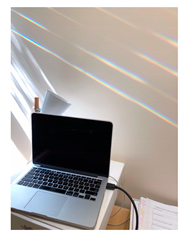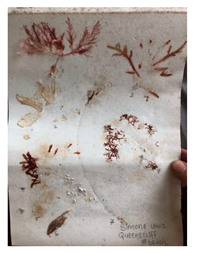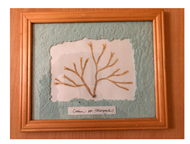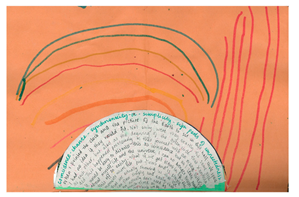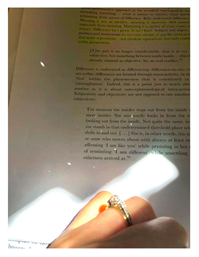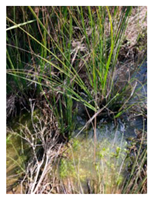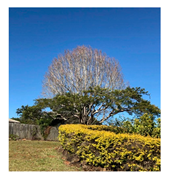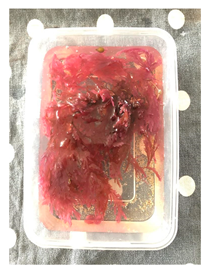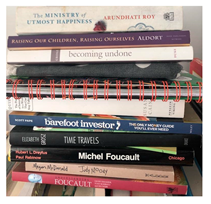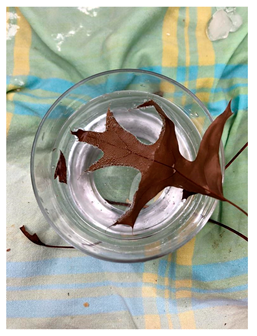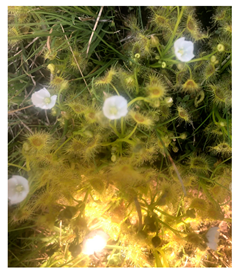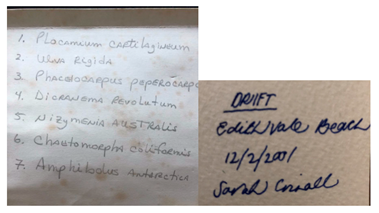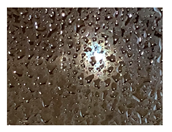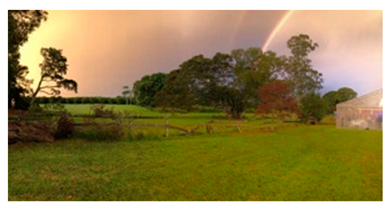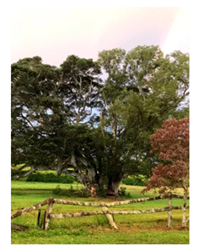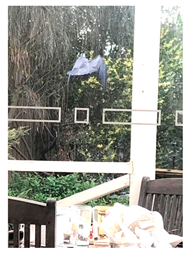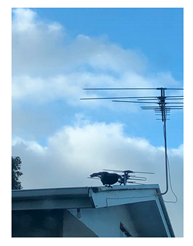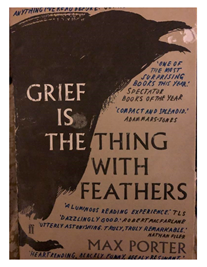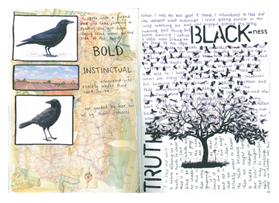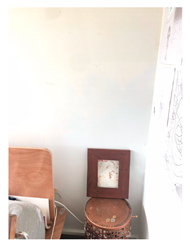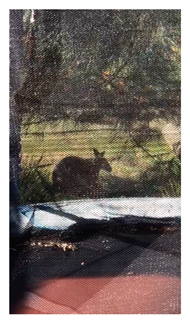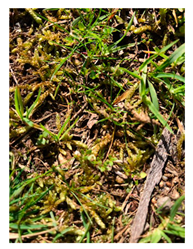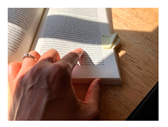Growing Communities in a Garden Undone: Worldly Justice, Withinness and Women
Abstract
1. The Entrance
‘To what can feminist theory aspirethat open us up to the embrace of an unknown and open ended future,that bring into existence new kinds of beings,new kinds of subjectsandnew relations to objects’
slowpeas in teethWediffractRainbowtosee what emerges nextsunraydance grappling
Algal pressing from my 21stPhotosynthesisisingPhoto-cin-thesisisingPhoto-cin-press-isPress-cin-thesisAlgal pressing from my 21st
Found it in a treasure boxA page from my journalrainbowsand words on synchronicitytravellingparallel lives and worldssynchronicitycin-chron-I-sip-teanowI remember sipping a blue colour caravan tea with youcinchronicityimaginehow we could beinrelationshipsif we met someone ‘anew’ each time we saw them again
talking about FoucaultI am grappling with the differencebetween discourse and discursivityand rainbow butnow am wondering about the difference between discursive and nondiscursive practicesor perhaps the relationship between the Foucault described ‘said and unsaid’ thatFoucault leftUnsaid.
2. Part One: On light
MulchingA short share with blog today about the winter greenscaptivating.They lay across the landscapeThey bound out and up at mefrom places.The first green to hold my hand was the grass budding out of the roadOur shared blog,As in our cothinking threads th(inking)reading together apartBoth said and unsaidIt captures our bodies thinkingA body thinkingBut it is other to cognitive rational knowing.The unsaid speaking bodies
on Saturdayi learnt a dancewhere we aligned like gemini sisterson Sundayi went for a walkmy friend commented on how part of the treehad lost it’s leavesi said it is actually twobeing as onei’d noticed that beforebut now i see the trees in their dance too
it seems like i-dentifyingwith the ikeeps out theotherthe word (i-n-divi-duality)In-dividePerpetuates the divided duality ofone-from-other.I gathered these pieces of rhodophyta after sitting on a red rock on my walk this morningThe pool of red algae laid on the paperWaving and washing and then as the paper roseIt pressed against the wet algaelay a cloth napkin over itwrapped it in my favourite dotted tea toweland slid it between a pile of books“Becoming undone” and “dinosaurs”People will think the seaweed is a book
Dear 100 yo Acorn treeAt home in my back yard you stand And birds visit you all day I see Today we made patterns with your acorns and leaves Doublcorns Tinycorns Hatted and hatless corns reveal themselves, acorn tree And you watched while we discovered you Looked Collected Aged and lay under youYou watched me grow up acorn tree And now my children are beneath your green red two tone wings A raven has just landed Black and stealth after the rustle of her feet securing herself upon your tendrils trunkEdie has returned after asking me to lay down under you and waitraven calls Arrr arrrrr arrrr arrrr Edie has something to say Meeeeeeerrrrr errrrr To the ravenWho still mostly silently sits.
LiveLoveLieove.
waitraven say Meeeeeeerrrrr errrrr Tocalls Arrr arrrrr arrrr arrrr Edie
‘so much happensin a touch:an infinity of others—other beings, other spaces, other times—are aroused’
Today my appointment timely after our meeting unearthed another layer of mothering imprints as scar-tissue on body. Something bubbles to the surface—like water breathed out through my stomata—the process of bodymind and I could feel the blog becoming through the experienceAnd now you find me reading about the healing properties of treeIs that the energy that one plant sends another?That flows. Can we learn a new humanness from trees?Though trees age more slowly than humansThey have the same “time”.Scar born from not honouring nature time, the cycles of natureFixed on social time, pushed by others time,A reminder to listen more closely to cycles.The research, published in the journal Plant Physiology, reveals that plants react in various ways when patted or touched.Took my walk phoneless yesterdaySundews stayed with me til todayThey’re abundant along Lawson street swales at the momentLooked up there movement to see if it was light-relatedNoIt is the kind of movement that blurs the plant—animal divide
No mourning of lossI love this process with youHealingRegeneratingUndoingRetreatingexposing.
I have a pressing dug from under the bed. This algal gift,given from you to me two decades before, is nibbled on.Hints of the alga, Plocamium remain.The botanical names written in grey lead indicate what the others,invisible now, were.
‘When two hands touch,there is a sensuality of the flesh,an exchange of warmth,a feeling of pressure,of presence,a proximity of otherness that brings the other nearly asclose as oneself.Perhaps closer.And if the two hands belong to one person,might this not enliven an uncanny sense of the otherness of the self’
‘sensuality of the flesh,exchange of warmth,feeling of pressure,of presence’
on sunday i spoke with another sister friend about why there is this drive that overrides the voice of womanly body that is tired or hungry or not enjoying herself is it because we think as women we need to be able to do it all?do we not trust the abundance that is there constantly waiting for us when we honour our wom(b)anly body first? social impositions, baradian material discursive forces (also of deleuze & guattarian nature as expressed through Massumi 1992) impacts on material form without giving materiality it’s own agency is this agential realism?)a walk, my friendi went, I returnMy body heading downMoving logs of body lily pilyAlike sisters on Sundaylily pily sisterLove seaweed sister
…night day moon sun traversingInfinitely and expandingly like the universe🌌this sparkling light ray passing my gaze,✨🌳 🍎You are my breathIn out in out
you are my breath. In out in out.Returns me to the simplicity of breathingOf being withOtherB(r)e(ath)ingI like that being is in breathingOh yes! Here it is: breathing beingYes. AncientI have mentioned nothing but she is asking me to call her ‘Plant’
I count your rings to know your ageAttunedsun and daughter-sun speckle light through treesshine brightlyYesterday, sun peeked under bathroom doorrefracted through shower screen droplets and circular rainbowsoh these circular rainbow beads water my face!As you spoke, sparkles of light danced across the roof of your carthen,the light reflected off my engagement ring and sparkled across my desk.dancing light sparklesa timely reminderfor lifefor writingfor beingAs the sea sparklesSo did youA calm sea floating in my visionNow we have chopped you down light pours inStill
a giant double rainbowlanding in this treeit perfectly looked like asingletreebutit wastwo being oneeach sidelooked to support the otherin an awkwardyet perfectly placedsymbiotic growingthe support was a balanceand not a leaning onit was leaning awayand this is whatenabled thegrowing togetherquite the oppositeof what I have consideredand understoodgrowing to(gether to) be
ButterfliesMetamorphosingCycle of contributionsHibernates when left aloneSomething beautiful unfolds.Such synergy.Our contributions have blossomed out of.Difference and diffractionDiffractive patterningM-others as more than mothersWomb-andEntangled identityShift from roles to rolesRedefining motheringLight is coming throughPlay of ordering sense and meaning makingI love that orderNature’s messinessReconcepuatliaationsOf timeDoesn’t need to be long timeHow much do we operate with the anxiety of body tensionAt minds leadUncomfortable with mindfulness?How about we change it to bodyfulness?Listening to cells of the bodyOn eyesWe have blind spotsAnd light receptors in our akinWe don’t know why yetShining a light in a child’s eye in hyperactivityDull lightWhen they are focusedCalmShines lighterAs we get olderIt dullsThe life that oozes and beams out of each object
working with ‘past matter’takes me to lightthe way what we have was made so long agoWhile you were writing this I was re-reading,‘oh yes, this sparkling light ray passing my gaze,’
Light n tangyTreading lightlyA light touchLight as a feather
3. Part Two: On Dark
‘Darkness is not mere absence,But ratheran abundance’
ravens are everywhere hereRaven came for lunch.The way we writ we write togetherreminds me of ‘Raven’,
are we living if we are lead by a community of “should”?Raven invites us on her wings into the in-between of dark light / night day to blur the binary stereotypes?Today ravens appeared along the roadsidelooking for cationto turn dead back to lifeas a ‘pulse’ every few kilometres, o noticed.They weren’t operating in time more than night / day rhythms thoughfor meI felt another kind of tick tock that was more of a heartbeat that pulsed with inspiration each time I saw themI’m back with our feathered wom(b)anliness.in tensionin wombin womanIn womb and in this book the crow comes to live with the family after the mother dies.Leiove
Seaweed pressings are in the spacesOn white pagesAnd light dotssea sparkleBouncing after singingGlass of water glisteningbathing an acorn leafin a drink of lightElectrons call into question the nature of self with Barad, they want to stay with the indeterminacy and to never settleWhat is a mothering that never settles?Barad’s electron goes alongEmits a photonAnd thenHorrorAbsorbs it? (Barad 2012)The raven seems the epitome of animal darkness flying inThis is not surprising to us right?We are uncoding dark matter that gathers (in) here
‘The fact that things are disturbedwhen we measure them is not astartling new resultof quantum physics—this point already follows from classical physics…When light bounces off a relatively large object,the disturbance is negligible relative to the accuracy of the measurement.That is,it is often the case that any such disturbance is too small to notice.(For example, we don’t notice the furniture being rearrangedin the room when we turn a light on in a dark room,although this is strictly the case)’
the engulfingreturning to the bodymoving kind‘Researcher: “So do you hear the plant?”Raven: “Yeah, but you have to hear it through your heart.”Researcher: “I was going to ask where you hear it… do you hear it in your heart?”Raven: “Little words curl into your mind. You have to know that you’re notthinking’
‘If you’re thinking then you’re not really listening.See I can’t do it now when I’m talking…it’s not ‘speaking’ it’s more like energy orsignals. You don’t hear it out loud. It’s something that your mind and only your mind can understand because nature is that open to any language… It’s like the birds with those signals, like when you see a bird flapping up in the sky and a flock of birds how they all move at the same time, it’s because they tell each other like through mental speaking’
‘Raven’s descriptions of how she lives in and experiencesthe world shows a deep blurring of the lines between her ‘self’ and the ‘other’,“Sometimes I feel like Raven actually feels fall”.“The season?” a researcher asks.“Ya, the falling of the leaves, the coming of cold, the coming of weather as she standsthere and thinks.”The staff member describes it as her “soaking” it all in’
Flooded with midday lightWallaby in the darkSunlight and moss for youThe quietly quietly of plants and lightShhhhShhh and still said the girlsRespecting m-othering3M-other has returned with babe in pouchI thought to respond to you of it after two days ago the children and I were kicking the soccer ball in the backyard (where raven watched) and my daughter told me: If we take miss from here, the moss over there will die too. I know this moss grows in the shade, needs the shade, I just don’t know how I know. Noone has told me.
The sunlight has written us a love letter back:Mothers,talking yesterday morningI thought a small child was running on the roofIt was raven telling truths of the day awakeThe world articulates itself through the beat and best (the ones you can hear) of Raven’s steps… yes!Love the sunlight-as-highlighterUncoding dark matter that gathers (in) hereOut the kitchen window raven landsI’m thinking about how you worked in the darkness and found the dark matter of our paperA whoosh whoosh is the wings of raven as she flies off with my thoughtShe is picking paper from the swamp paperbark limb I dragged fromLawson street after it fellTo love in our gardenFor her nest
4. Open-Ending
‘operates on a field ofentangled and confused parchmentson documents thathave been scratchedover and re-copiedmany times’
I sneak a few words before bedbecauseno coincidencethis tooisa thingihave beenfeelingIntothis thingyou calledsolitudeat nightbefore i slumberi am working ona depth of presenceof being withthe worldbutwith mefirstfeels differentto being with the world asI amin the dayit’s likei amwith natureMOREand other lifelessi’ll go there now… lightly
How does growing (with) plant-life, amongst what is ‘said’ and ‘unsaid’, matter (to) the world as it turns?What counts as a meaningful world?
how might communities re-imagine life in relation to what is said and unsaid?
Author Contributions
Funding
Conflicts of Interest
References
- Barad, Karen. 2007. Meeting the Universe Halfway. Durham and London: Duke University Press. [Google Scholar]
- Barad, Karen. 2010. Quantum entanglements and hauntological relations. Derrida Today 3: 240–68. [Google Scholar] [CrossRef]
- Barad, Karen. 2012. On touching—The inhuman that therefore I am. Differences 23: 206–23. [Google Scholar] [CrossRef]
- Barad, Karen. 2014. Diffracting Diffraction: Cutting Together-Apart. Parallax 20: 168–87. [Google Scholar] [CrossRef]
- Blenkinsop, Sean, and Laura Piersol. 2013. Listening to the literal: Orientations towards how nature communicates. Phenomenology & Practice 7: 41–60. [Google Scholar]
- Blom, Simone Miranda. 2018. Conceptualizing Parent (ing) Childhoodnature Through Significant Life Experience. In Research Handbook on Childhoodnature: Assemblages of Childhood and Nature Research. Edited by Amy Cutter-Mackenzie-Knowles, Karen Malone and Elisabeth Barratt. Cham: Springer, pp. 1–26. [Google Scholar]
- Brown, Shae L., Lisa Siegel, and Simone Miranda Blom. 2020. Entanglements of matter and meaning: The importance of the philosophy of Karen Barad for environmental education. Australian Journal of Environmental Education. [Google Scholar] [CrossRef]
- Burin, Margaret. 2018. People from All over the World Are Sending Emails to Melbourne’s Trees. ABC News. December 12. Available online: https://www.abc.net.au/news/2018-12-12/people-are-emailing-trees/10468964 (accessed on 18 December 2019).
- Charteris, Jennifer, Sarah M. Crinall, Linette Etheredge, Eileen Honan, and Mirka Koro-Ljungberg. 2019. Writing, Haecceity, Data, and Maybe More. Qualitative Inquiry. [Google Scholar] [CrossRef]
- Crinall, Sarah. 2016. Bodyplacetime: Painting and Blogging ‘dirty messy’ humannatured becomings. In Reimagining Sustainability in Precarious Times. Edited by Karen Malone, Son Truong and Tonia Gray. Singapore: Springer Press, pp. 95–114. [Google Scholar]
- Crinall, Sarah. 2019. Sustaining Childhood Natures: The Art of Becoming with Water. Singapore: Springer Press. [Google Scholar]
- Crinall, Sarah M., and Anna Vladimirova. 2020. Embodied motherly research: Re-birthing sustenance through the common (im)material. In (Re)birthing the Feminine in Academe: Creating Spaces of Motherhood in Patriarchal Contexts. Edited by Linda Henderson, Ali L. Black and Susanne Garvis. London: Palgrave Macmillan. [Google Scholar]
- Cronin, Thomas W., and Sönke Johnsen. 2016. Extraocular, non-visual, and simple photoreceptors: An introduction to the symposium. Integrative and Comparative Biology 56: 758–63. [Google Scholar] [CrossRef] [PubMed][Green Version]
- Crutzen, Paul J., and Eugene F. Stroermer. 2000. The Anthropocene. Global Change Newsletter 41: 17. [Google Scholar]
- Cutter-Mackenzie-Knowles, Amy, Karen Malone, and Elizabeth Barratt Hacking, eds. 2019. Research Handbook on Childhoodnature. Cham: Springer. [Google Scholar]
- Deleuze, Gilles, and Felix Guattari. 1994. What Is Philosophy? New York: Columbia University Press. [Google Scholar]
- Dickinson, Elizabeth. 2013. The misdiagnosis: Rethinking “nature-deficit disorder”. Environmental Communication: A Journal of Nature and Culture 7: 315–35. [Google Scholar] [CrossRef]
- Foucault, Michel. 1978. The History of Sexuality. Paris: Éditions Gallimard, vol. 1. [Google Scholar]
- Gianoli, Ernesto, and Fernando Carrasco-Urra. 2014. Leaf Mimicry in a Climbing Plant Protects against Herbivory. Current Biology 24: 984–87. [Google Scholar] [CrossRef]
- Grosz, Elizabeth. 1994. Volatile Bodies. Bloomington: Indiana University Press. [Google Scholar]
- Grosz, Elizabeth. 2005. Time Travels. Durham and London: Duke University Press. [Google Scholar]
- Grosz, Elizabeth. 2011. Becoming Undone. Durham & London: Duke University Press. [Google Scholar]
- Haraway, Donna. 2016. Staying with the Trouble: Making Kin in the Chthulucene. Durham and London: Duke University Press. [Google Scholar]
- Kahn, Peter H., and Patricia H. Hasbach. 2013. The Rediscovery of the Wild. Hong Kong and Cambridge: MIT Press. [Google Scholar]
- Le Guin, Ursula K., and David Naimon. 2018. Ursula Le Guin: Conversations on writing with David Naimon. Portland: Tin House Books. [Google Scholar]
- MacLure, Maggie. 2013. Promiscuous feminists postscript. Journal of Qualitative Studies in Education 26: 625–28. [Google Scholar] [CrossRef]
- Massumi, Brian. 1992. A User’s Guide to Capitalism and Schizophrenia: Deviations from Deleuze and Guattari. Cambridge: MIT Press. [Google Scholar]
- Maxmen, Amy. 2018. ‘Dark matter’ DNA influences brain development. Nature News. January 18. Available online: https://www.nature.com/articles/d41586-018-00920-x (accessed on 18 December 2019).
- Murris, Karin. 2018. Posthuman Child and the Diffractive Teacher: Decolonizing the Nature/Culture Binary. In Research Handbook on Childhoodnature: Assemblages of Childhood and Nature Research. Edited by Amy Cutter-Mackenzie, Karen Malone and Elizabeth Barratt Hacking. Cham: Springer International Publishing, pp. 1–25. [Google Scholar]
- Osborn, Maia, Simone Miranda Blom, Helen Widdop-Quinton, and Claudio Aguayo. 2019. De-imagining and Reinvigorating Learning with/in/as/for Community, Through Self, Other and Place. In Touchstones for Deterritorializing Socioecological Learning. Edited by Amy Cutter-Mackenzie-Knowles, Alexandra Lasczik, Judith Wilks, Marianne Logan, Angela Turner and Wendy Boyd. Cham: Palgrave Macmillan, pp. 189–230. [Google Scholar]
- Payne, Phillip. 1997. Embodiment and Environmental Education. Environmental Education Research 3: 133–53. [Google Scholar] [CrossRef]
- Porter, Max. 2015. Grief Is the Thing with Feathers. London: Faber & Faber. [Google Scholar]
- Powell, Devin. 2013. In pursuit of dark matter. Proceedings for the National Academy of Sciences of the United States of America 110: 14113–15. [Google Scholar] [CrossRef] [PubMed]
- Rautio, Pauliina. 2013. Children who carry stones in their pockets: On autotelic material practices in everyday life. Children’s Geographies 11: 394–408. [Google Scholar] [CrossRef]
- Somerville, Margaret. 1999. Body/Landscape Journals. Melbourne: Spinifex Press. [Google Scholar]
- Somerville, Margaret. 2015. Writing the post-human ‘I’: the problem of the human subject in the more-than-human world. Paper presented at the American Education Research Association Meeting, Chicago, IL, USA, April 16–20. [Google Scholar]
- St. Pierre, Elizabeth A. 2014. A Brief and Personal History of Qualitative Research. Journal of Curriculum Theorizing 30: 1–19. [Google Scholar]
- Taylor, Affrica. 2017. Beyond stewardship: common world pedagogies for the Anthropocene. Environmental Education Research 23: 1448–61. [Google Scholar] [CrossRef]
- Trafton, Anne. 2016. Nanobionic spinach plants detect explosives. MIT News. October 31. Available online: http://news.mit.edu/2016/nanobionic-spinach-plants-detect-explosives-1031 (accessed on 18 December 2019).
- Ulmer, Jasmine. 2017. Writing ‘Data’ Across Space, Time, and Matter. In Disrupting Data in Qualitative Inquiry: Entanglements with the Post-Critical and Post-Anthropocentric. Edited by Mirka Koro-Ljungberg, Marek Tesar and Teija Loytonen. New York: Peter Lang Publishing Inc., pp. 135–48. [Google Scholar]
- Vladimirova, Anna, and Pauliina Rautio. 2018. Unplanning research with a curious practice methodology: Emergence of childrenforest in the context of Finland. In Research Handbook on Childhoodnature. Edited by Amy Cutter-Mackenzie, Karen Malone and Elizabeth Barratt Hacking. Cham: Springer, pp. 1–26. [Google Scholar]
| 1 | This article was written as a collaboration. The order of authors names is based on the writer who encountered the publication invitation as first author. |
| 2 | |
| 3 | This m-othering emerges via philosophies on mothering as sustaining in academia (Crinall and Vladimirova 2020). As if under a moss-bed, mothers—multiplicit and material others - are many while also one. |
© 2020 by the authors. Licensee MDPI, Basel, Switzerland. This article is an open access article distributed under the terms and conditions of the Creative Commons Attribution (CC BY) license (http://creativecommons.org/licenses/by/4.0/).
Share and Cite
Blom, S.M.; Crinall, S. Growing Communities in a Garden Undone: Worldly Justice, Withinness and Women. Genealogy 2020, 4, 42. https://doi.org/10.3390/genealogy4020042
Blom SM, Crinall S. Growing Communities in a Garden Undone: Worldly Justice, Withinness and Women. Genealogy. 2020; 4(2):42. https://doi.org/10.3390/genealogy4020042
Chicago/Turabian StyleBlom, Simone Miranda, and Sarah Crinall. 2020. "Growing Communities in a Garden Undone: Worldly Justice, Withinness and Women" Genealogy 4, no. 2: 42. https://doi.org/10.3390/genealogy4020042
APA StyleBlom, S. M., & Crinall, S. (2020). Growing Communities in a Garden Undone: Worldly Justice, Withinness and Women. Genealogy, 4(2), 42. https://doi.org/10.3390/genealogy4020042




